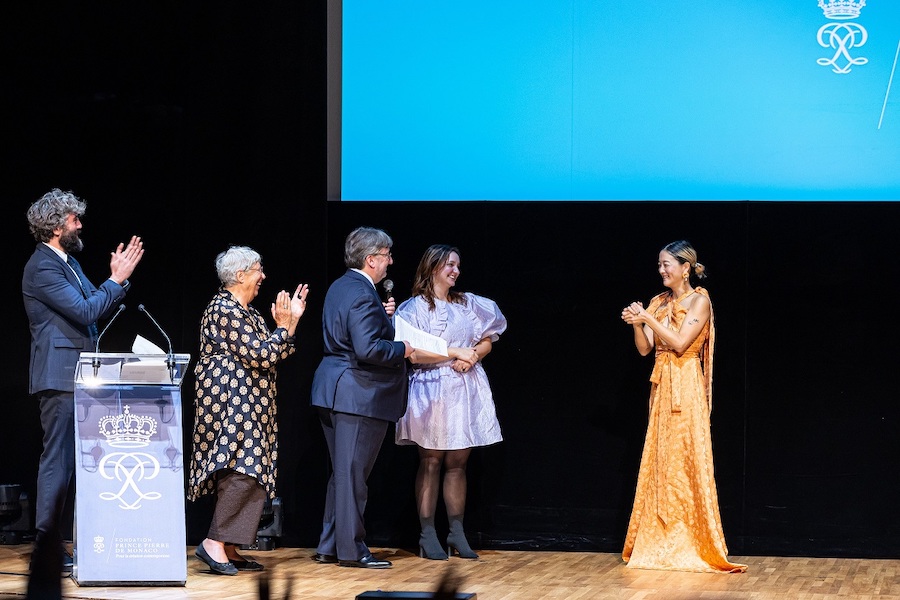A rendition of The Star Spangled Banner, performed in sign language during the 2020 Super Bowl, has won Christine Sun Kim the top prize in this year’s Prince Pierre of Monaco Foundation awards.
The winners of the 2022 edition of the Prince Pierre Foundation Prizes were announced during a Proclamation Ceremony which took place on Tuesday 11th October at the Opéra Garnier in Monaco, in the presence of Foundation President Caroline, Princess of Hanover. The International Prize for Contemporary Art was awarded to Christine Sun Kim for her work The Star-Spangled Banner (2020), while DAAR was awarded the Research Grant.
The Star-Spangled Banner was screened during the ceremony and will be presented at Casa Encendida in Madrid from 10th November to 26th February 2023, alongside two other works by the artist. The Foundation will present this exhibition at the International Contemporary Art Fair (ARCO).
Awarded for the first time in 1965, the International Prize for Contemporary Art (PIAC) has been organised since 1983 by the Prince Pierre of Monaco Foundation. From 2005, it’s been awarded every three years, chosen by the Artistic Council on the proposals of international experts from the art world.
The winner is awarded a sum of €75,000, including the possible financing of the production of an original work.
For the 2022 edition of PIAC, each member of the Artistic Council asked three international experts to present a piece created over the past two years and considered to be the most accomplished and the most representative of the work of an artist.
Artist David Horvitz proposed the work of Christine Sun Kim. It is a performance of her interpretation of the United States national anthem in American Sign Language (ASL) during the Super Bowl 2020 in front of millions of viewers.
“I am pleased to nominate The Star-Spangled Banner for the International Prize for Contemporary Art,” David Horvitz said. “The work synthesises multiple aspects of her practice (her voice). It is at the intersection of the different platforms through which it spreads and grows. The work is both a drawing and a translation from English to ASL. It is a document, a reference.”
According to Artistic Director of PIAC Cristiano Raimondo, “Kim builds a work where signs, gestures and their signifiers are constantly enriched, offering a bridge between the world of the hearing and that of the deaf, and this through the construction of an artistic language which goes from the sign to the graphic and from the graphic to the representation of the music. A musical note cannot be entirely contained and expressed on paper and the same goes for a concept translated by ASL: both are spatialised and modulated, so that the slightest change can modify their meaning.”
In addition, for the first time this year, a Research Grant was awarded. It supports an artist, an institution, a collective, or an art historian in their research work, in progress or to come, in connection with the Mediterranean Basin. The Prize was awarded to DAAR – Decolonising Architecture Art Research.
The artistic practice of DAAR – made up of Sandi Hilal and Alessandro Petti – is situated between architecture, art, pedagogy and politics. Over the past two decades, they have developed a series of research projects that are both theoretically ambitious and concretely committed to the struggle for justice and equality.
During the awards ceremony, Vénus Khoury-Ghata was awarded the literary grand prize. The Bourse de la Découverte prize was awarded to Thomas Louis for his first novel Les Chiens de faïence, published by La Martinière. The high school students’ favorite was awarded to Marie Vingtras,for her first novel Blizzard, published by Olivier.
The Coup de Coeur des Jeunes Mélomanes was awarded to York Höller for his work Viola Concerto (2016-2017) and the Musical Springboard to the Kyiv Symphony Orchestra.
The Principality Prize, awarded jointly by the Philosophical Meetings and the Prince Pierre of Monaco Foundation, was awarded to Philippe Descola, for all of his work.
Photo credit: Philippe Fitte
